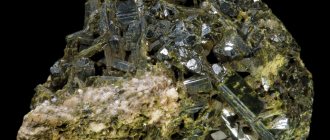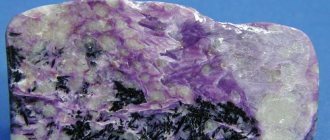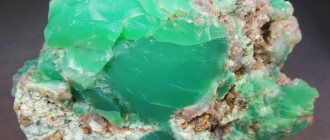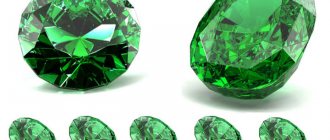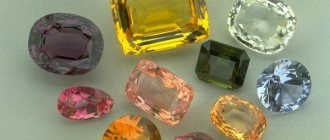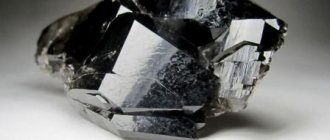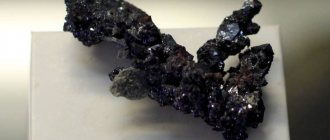Story. Origin
Ammolite is a very rare fossilized part of an ammonite. This is a layer with pearlescent tints that forms on its shell. Ammonites are cephalopods that lived in the seas about 300–400 million years ago .
Their shells are found on all continents, but the ammolite layer on them is very rare. The name of the stone is made up of the first part of the word “ammonite” and the word Lithos - translated from Greek - stone. Ammon is a spelling in Greek literature of the Egyptian god Amun, who was depicted with the head of a ram with curled horns resembling ammonite shells.
Trade names of this gem:
- Ammolite;
- Calcinitis;
- Korit;
- Perlanorilsk.
Ammolite, strictly speaking, is not considered a mineral, since it is a nacreous layer of shells of ancient fossilized mollusks. The thickness of this layer is from 1 to 12 mm .
In 1908, in the area of Alberta, Canada, along the St. Mary's River, representatives of the National Geological Survey discovered a bright, iridescent gem. It was shaped like a shell, resembling a curled ram's horn, and like most organic stones, it was composed of calcium carbonate. The samples found had complex patterns, a variety of shade combinations, and a multi-layered gradient.
When the flow of streams and rivers erodes the fossilized shells of ammonites, they become like bison; the Indians call them “buffalo stones.”
After numerous studies, scientists have identified the fairly high quality of ammolite, so in 1981 the International Conference of Jewelers officially awarded it the status of a precious stone. After this, industrial mining of this mineral began.
Shell of an ancient ammonite mollusk, the mother-of-pearl layer of which is ammolite
Stories: Paleolithic, god Amon and the new phenomenon of ammolite
Just half a century ago, mineral collectors were mainly interested in ammolite stones (as well as ammonites). As a gemstone, ammolites appeared on the jewelry markets in 1962. A fossil with a stunningly beautiful appearance was “promoted” by Canadian jeweler Marcel Charbonneau.
How ammolite was born
300 million years ago, warm ocean waves splashed on the site of the Rocky Mountains. Ammonite mollusks lived there with an interesting shell shape, often twisted into a spiral. The sizes of shells (and mollusks) ranged from 1 centimeter to 2 meters in diameter.
The cephalopods lived and did not grieve, but mountain-building processes began and volcanic activity increased sharply. The ocean retreated and mountains began to grow in its place. It was there, in the foothills, that millions of mollusks living in shell houses were buried.
That's what they called it
There are several versions of where the name came from. Most mineralogists believe that the stone is named after the ancient Egyptian sun god, Amon Ra.
Ammolites are mentioned by Pliny the Elder in Natural History. He calls the stone “horns of Amun” or “ammonis cornua” - the ancient Egyptian god Amon was depicted with ram horns.
We recommend: CLEANING TOPAZ correctly | All methods
If you come across the words calcentin, corite, precious aragonite, seven-color stone of prosperity, know that we are talking about ammolite.
Description
Ammolite color contains all the colors of the rainbow.
Its iridescence (that is, its iridescent glow in bright light) is very impressive. When rotated 360 degrees, the mother-of-pearl layer of shells tends to shimmer. Interestingly, the color of ammolite does not depend on pigmentation, like other stones, but on the refraction and reflection of rays in the layers of mother-of-pearl. Only tropical butterflies have such natural color and brightness.
The top layer of the stone is covered with small cracks that create unique patterns. Some examples of pearlescent cracks are similar to reptile skin.
This rainbow gem is the closest relative of pearls and is considered the most valuable among stones of organic origin, which also include mother of pearl, amber, bezoar, and jet.
When was ammolite formed?
Once upon a time, about 100 million years ago, the Western Interior Sea stretched east of the Rocky Mountains on the American continent. Where the taiga and prairie stretch today, the wind drove salty sea waves, and the depths below were saturated with ancient life. Numerous schools of fish preyed on cephalopods - belemnites. Small fish were followed by large ones - ancient sharks competed with six-meter xyphactines for prey. But they themselves found their death in the teeth of pliosaurs, huge sea lizards. The end of the age of reptiles was approaching, but in the meantime the short-necked and powerful-mouthed pliosaurs, the graceful long-necked elasmosaurs and a variety of saltwater crocodiles enjoyed their supremacy in the seas. Our heroes, the ammonites, also lived in this world full of dangers. Cephalopods with a shell twisted into a spiral, they hunted small fish in the water column, diving and swimming up like miniature submarines. When death from the teeth of a pliosaur or large fish overtook them, the shell of the mollusk sank to the bottom and was quickly covered with sand and silt, thanks to the strong bottom current. Gradually, after tens of thousands of years, some of these shells became fossilized. Rivers flowing into this shallow sea from the Rocky Mountains enriched the waters with salts and minerals, creating a unique chemical environment. Under these conditions, the shell of the mollusk deteriorated slowly, and the inner nacreous layer had time to become saturated with iron and silicon compounds, which allowed it to survive for many millions of years.
Physicochemical characteristics
The chemical composition of ammolite is complex. Various impurities (copper, aluminum, titanium and others) affect the change in the composition and color of the stone. The main substance is aragonite (one of the stable forms of calcium carbonate). During fossilization, part of the aragonite is replaced by quartz and pyrite.
- The chemical formula is CaCO3 .
- Impurities - FeS2, SiO2 .
- Color - red-yellow, red-green, bluish-green, blue-green, rarely pink and purple. Some specimens contain the entire spectrum of the rainbow.
- Gloss - depends on its composition, often pearlescent.
- Transparency - opaque, translucent at thin edges.
- Hardness - 4,5–5,5.
- Density - 2.6–2.85 g / cm3 .
It is a rather fragile stone with a diamond-shaped structure.
Buy ammolite jewelry
At the beginning of the “jewelry biography”, stones could be bought cheaply, and they were set in cupronickel. Nowadays, rainbow stones are set in precious metal and framed with expensive gems.
We recommend: COGNAC DIAMONDS
The price of a small piece of ammolite (2x2 centimeters) of high quality in rainbow colors can reach $1000.
Such stones are rarely found. The color largely depends on the thickness of the aragonite layer. The thinnest layers usually have purple and blue colors, while the thicker layers have red and green shades.
Jewelry with ammolite
Such a fragile stone
Ammolites have low hardness. Therefore, jewelers prefer to set ammonite pieces in a tight, gap-free metal frame. Tripleting and doubling technologies are also used for stone processing.
- When doubling, a thin (very thin) plate of ammonite is glued onto a synthetic backing made of black spinel. The plate is impregnated with polymer adhesives to strengthen the gem.
- When tripletting, a third, top layer is added to this stone “sandwich” - a transparent mineral layer.
Place of Birth
Ammolites occur in sedimentary rocks of limestone, clay and marl.
They are found on almost all continents, but deposits are so far known only in North America: in the Canadian province of Alberta and in the northern USA, on the eastern side of the Rocky Mountains. The formation of the gem in these places occurred due to the transformation of the boundaries of the ocean and due to volcanic processes - as a result, colonies of ammonites were buried under a layer of ash and rocky rocks. Specimens from those regions, which have very bright colors, are prized by fossil lovers. After ammolite was recognized in 1981, industrial mining of this gem began in the Canadian Bear paw deposit. There they find ammonite samples of varying quality, but the ammolite layer on them is no more than 1 mm .
In Russia, it began to be mined in 2021 at a recently discovered deposit in Taimyr near Norilsk. They were given the trade name Perlanorilsk. These ammolites are not inferior in quality to Canadian ones; they have good thickness - up to 3 mm and excellent iridescence. They are located in strong rocks, while Canadian ones are found in clays, so impregnation of the rock is required before mining.
Ammolites were also discovered in the Ulyanovsk region, but they do not have iridescence due to the weathering of ammonite shells, since the deposits are located close to the surface of the earth.
Read also : Chiastolite - a stone that gives inner harmony
Where did ancient cephalopods live?
The location of ammolites is sedimentary rocks.
Now 90% of ammolite production comes from the Bear paw deposit. It is located in the Rocky Mountains, in southern Canada. Experts believe that at the current rate of production, the deposit will dry up in 20 years.
There is no need to worry just yet - the Russian Taimyr region has recently opened its storehouse of ammolites. And the quality of our ammolites is no worse than Canadian ones. And ours are easier to get. Taimyr ammolites are found in hard rocks. Canadian ones are in clays, and this requires impregnation of the rock. Extra time, extra money (increased production costs).
Ammolite is found in Madagascar.
Informative: rainbow pieces of stone can be found on the banks of the Volga, but they do not form industrial deposits. We recommend: WHERE ARE EMERALDS MINED?
Colors
Ammolites differ in shades. Some stones have several shades of the same color, others have a color where several different colors merge into a single whole.
The most common specimens are red-green. There are also combinations of green and blue, yellow and red, as well as other colors.
In addition, the surface of the stone may have patterns reminiscent of antique stained glass or the skin of a snake.
The quality of ammolites is assessed based on the number of color shades:
- The highest quality (category AA) - stones with a full color palette (that is, seven-color), as well as 4-6 colors.
- Average (category A+) - several shades of two or three colors.
- Lowest (category A-) - several shades of the same color.
This grading system in relation to these stones is not unified , since different manufacturers assess the quality of these stones differently, in general, based on the following criteria:
- number of flowers;
- irisation.
Ammolite Processing Process
Freshly mined stone, as a rule, does not shine with colors and looks inconspicuous. In order to reveal the entire color palette, it needs processing. It happens that it begins to shine after high-quality polishing, but, as a rule, the processing process is much more complicated.
Ammolite in general is a fragile and sensitive stone. It has a layered structure and is easily scratched with a knife. To strengthen it, it is often impregnated with special polymers or epoxy resin.
We also do not forget that this is the inner layer of the shell, which means that it is often hidden under a layer of fossilized remains of the ammonite shell itself. Only a true master can remove excess layers and reveal the beauty of the stone, and needless to say, the work is done by hand. By removing layers of aragonite, craftsmen try to release all the colors contained in the stone. Such stones, containing the entire rainbow palette, are valued above all else. Another direction in processing is the release of shades of the same color; this method is usually used for stones of purple and pink colors.
The end result is a beautiful, unique work of art. In the play of colors and shades, people see the most beautiful images, similar to the starry sky, the interweaving of the arms of galaxies and cosmic nebulae.
Application
Jewelry
Processing ammolite requires care. Experienced, skilled craftsmen work with him. The gem has a very thin layer. If before polishing it is 0.5–0.8 mm , then after it it is 0.3–0.5 mm . It is impossible to make a cabochon from it in the usual way, so the technology of making doublets and triplets is used. It allows you to use the finest mother-of-pearl in jewelry. As a result, the jewelry will be reliably protected from scratches and impacts. This manufacturing technology makes the jewelry durable.
The traditional cut of this stone is slab. Round specimens are high quality gems. Ammolite is fixed into the frame to give greater strength to the product. Previously, nickel silver and cupronickel were used as frames; now they are made of silver, gold and platinum.
Most often, jewelers make rings, rings, brooches, and earrings from this gem. Jewelry with this stone is mainly considered elite. They are not only beautiful, but also stylish and original.
Collecting
Collectors highly value this rare stone of organic origin. For them, samples are sold in natural form, as well as doublets and triplets on the original substrate.
Jewelry with mineral
Each ammolite fragment is unique in luster, color and pattern. Pricing is based on the size, shape, number of colors present, their brightness and the appearance of the jewelry. A natural gem can have any shape, be coated or uncoated.
Also read: Jade – unique capabilities and compatibility with names and zodiac signs
In jewelry, a fragment of ammolite is placed on a base; perhaps it will be a natural material, not exceeding a thickness of 1.5 mm. On top, a thin layer of shell is covered with an optical cap made of quartz, then the jewel can shimmer with all colors and be reliably protected from shocks and scratches.
It is known that the cost of stones depends on physical properties and carats. The market offers various jewelry with stones, and to buy jewelry, it is better to stock up on the necessary information. An indicative list of prices for some ammolite samples is presented:
- the minimum price for a single-color triangular fragment, 16.1–8.8 mm in size – $ 150.58;
- two-color stone, 28.4–13.4 mm in size, costs $394.88;
- a shell with a color resembling “dragon skin”, measuring 28.1–20.2 mm, costs $936.84;
- The ammolite, which has three colors and measures 28.5–18.7 mm, is valued at $1,181.64.
The gem is used to make rings, pendants, earrings and various ritual artifacts. Doublet or triplet manufacturing technologies make jewelry durable, which is passed on from generation to generation.
Medicinal properties
It is believed that if ammolite is worn as an amulet, it will protect against health problems.
Lithotherapists recommend using it in healing practices. They are sure that this gem, acting on human energy, helps normalize the circulation of energy flows in its owner.
The significance of ammolite for humans is that its medicinal properties help treat not only the body, but also the psyche. Its vibrations affect the physical and mental state of a person. The pebble gives the mood for recovery and charges the owner’s biofield with positive energy. This strengthens the immune system, helps maintain youth and beauty.
Attention! Ammolite can be used in the treatment of diseases only without neglecting the recommendations of doctors and without refusing official treatment.
This rainbow stone may lose its healing properties due to constant contact with the human body. Therefore, jewelry with it should not be worn constantly.
Lithotherapist's book
- The healers of Ancient Egypt used a healing stone to neutralize poisoning and intoxicate the body. Ammolite was used to treat childhood infectious diseases.
- Chinese medicine uses stone powder in elixirs to increase the possibility of conception.
- Recommended by lithotherapists for obstetrics, healing pulmonary diseases, and alleviating depressive conditions.
- When treating skin diseases, ointments with ground ammolite are indicated.
- Modern lithotherapists use ammolite for massage.
Magic properties
Ammolite stone comes from water. Indian shamans believed that the shells of ancient ammonites, lined with a shiny layer of ammolite, were capable of subjugating the water element. They used them in rituals to bring rain during droughts, and used them to search for sources of drinking water and underground streams.
It is believed that the ammolite talisman helps to more easily achieve contact with higher powers during meditation, as well as predict the future.
Interesting! Ammolite itself determines who it is suitable for as a protective amulet, and for whom it is suitable as a talisman that brings happiness and good luck.
The magical properties of ammolite are largely due to the fact that it senses the subtle vibrations of its owner and, if a person desires something, the gem pushes him in the right direction.
It is believed that the richer the color of the stone, the stronger its message to make a wish come true.
If an amulet made from this gem is worn in a secret pocket, it will protect the owner’s energy field from negative influences (the evil eye, etc.).
Some believe that ammolite jewelry helps prolong youth.
They are especially suitable for women - they add more charm and enhance attractiveness.
They say that this gem helps to find lost things, and its owner always turns out to be where needed and when needed.
It is believed that ammolite can subjugate the water element, so many believe that it helps people whose professions are related to water (fishermen, sailors, divers).
A bit of esotericism
Ammolite has been known to the indigenous people of the Rocky Mountains and adjacent prairies since ancient times. In the Blackfoot language it is called "aapoak", i.e. “small creeping/snake stone.” There is evidence that it was used as a talisman during buffalo hunts. Silhouettes of bison were carved from it, which, according to legend, brought good luck, health and strength to the owner.
In modern esotericism, the stone is, for obvious reasons, only recently known, and its symbolism is firmly associated with the water element, which is explained by its origin. The stone is recommended for sailors and divers, as well as all people in one way or another connected with the sea or having another “aquatic” profession. The spiral shape of large ammolites is also subject to esoteric reinterpretation. The spiral is a symbol of ordering and creation. This means that the life of the owner of such a stone will be structured, and his thoughts will become more logical and rational.
quick view add to cart
Who is suitable according to their zodiac sign?
Astrologers, studying the properties of ammolite, recognized that it is suitable for any zodiac sign.
Since this stone is associated with water, it provides special protection to the zodiac signs of the element of Water: Cancer, Scorpio, Pisces . For people born under these constellations, ammolite helps to overcome obstacles that arise along the path of life. It promotes the prosperity of its owner, brings good luck and health. With the help of such a talisman, a person can choose an activity that will bring success.
Ammolite provides no less assistance to the zodiac signs of the element of Air ( Gemini, Libra, Aquarius It especially helps those people who know what they want, but do not understand which way to choose to make their wish come true. The talisman will point out all the real opportunities for making your dream come true and will help you avoid troubles on the way to it.
This gem has a neutral attitude towards other zodiac signs. It will not make you happy, but it will not bring problems either, so all representatives of these zodiac signs can safely wear jewelry with this beautiful stone.
How does stone affect health?
The jewel that came to us from the depths of centuries helps not only to develop spiritually, but also to maintain health. In ancient times, it was mainly used to treat the organs of the reproductive system in women, it helped to get pregnant and safely bear the fetus.
As for modern times, first of all it is worth saying that ammolite is treated with special respect in China. Healers from the Middle Kingdom use it to treat diseases of internal organs, using techniques such as massage and application.
The stone is widely used today by European lithotherapists. Ammolites are used to treat skin diseases, including such a complex disease as psoriasis. It is also used to treat infectious diseases in children (including quite serious ones - measles, scarlet fever, etc.), purify the blood and improve the condition of the hair. In addition, it is important to note that the effectiveness of the stone has been noted for healing insomnia and depression.
How to wear
Ammolite is a very unusual, bright stone. It complements the look as an interesting accessory. This mother-of-pearl gem is so beautiful that it does not need the support of other stones in jewelry.
It is believed that the healing and magical properties of ammolite will be more beneficial if worn as a pendant, brooch or hair clip. You can also wear an ammolite amulet in a secret pocket - then it will protect the owner from negativity from the outside (damage, etc.).
For jewelry made from this stone, a frame made of gold or silver is more suitable.
Ammolite is a stone that is fragile and durable at the same time
The very effect of fascinating overflows is explained by the layered structure of the stone. As it forms, the main element - calcium carbonate - begins to be replaced by other chemical compounds. The result is a multi-layered structure through which light is intricately reflected and refracted.
Surprisingly, despite the fact that ammolite managed to survive under huge rocks, it itself is very fragile and not every jeweler is able to work with it. Only a skilled stone cutter will be able to turn a specimen that is not too noticeable in its raw form into a stone of mesmerizing beauty, removing the required amount of excess layers and without damaging the inner beauty.
To process a stone, it is placed on a special substrate and, when creating jewelry, it is artificially strengthened by adding resins, glass and quartz. And still, not every ammolite is so hard that it can exist in jewelry as a separate stone, so often its fragments only complement this or that jewelry, making it more original.
The stone is sensitive to various types of influences.
- Contact with a sharp object will most likely leave a scratch, so ammolite jewelry should be worn with extreme caution.
- Also, do not expose it to cosmetics - the jewelry must be removed before showering or applying cream.
How to care
Gemstones of organic origin require delicate care, and ammolite is no exception:
- Since this gem is fragile, it must be protected from any mechanical stress in order for it to remain intact.
- It is better to store it in a box with a soft interior or in a jewelry case. Neighborhood with other stones is undesirable, since almost all of them are much harder than ammolite.
- Do not allow perfumes and cosmetics to come into contact with the stone.
- Keep away from high temperatures and acids.
For cleaning, do not use alcohol, varnish, or household chemicals.
You can carefully wash the product with cold water and a little soap, then rinse under running water. It is better to dry naturally or blot with a soft cloth that absorbs moisture well.
You can clean ammolite with a pearl care product (since the composition of these stones is similar) or take it to a jeweler for cleaning.
How to distinguish from a fake
If the decorations are paired, then the ammolite should not be repeated. Each stone should have its own original and unusual pattern and color. Thus, everyone can distinguish a fake from natural ammolite.
Bracelet with ammolite
The presence of identical precious stones in the earrings indicates that the jeweler imitated the mineral. Jewelry in which an expensive stone is inserted has a registration number, which must be included in the product passport. It specifies where the ammolite is mined and who the producer is.
Interesting Facts
- Ammolite was popular during the era of travel. People used it to find sources of water. The Indians also used it to cause precipitation during droughts.
- In ancient times, fossil powder was used in massage. It helped to gain youth and improve the condition of the skin. Healers believed that a woman with ammolite would have an easier birth.
- The inhabitants of Ancient Egypt were sure that ammonite fossils allowed them to see prophetic dreams. There have been recorded cases where they actually came true.
Jewelry with the wonderful mineral amollite will be an ideal gift for any person. It will help improve your health and will perfectly complement any look.
Artificial shells
The desire to make jewelry cheaper leads to the production of artificial copies of natural minerals. Fake ammolites can be made of glass, plastic .
The cost of sets with similar stones will be noticeably lower than similar ones inlaid with real fossils.
Important! When purchasing stones of artificial origin, you should not count on magical, healing properties, since counterfeit specimens lack them.
Healing
Although ammolite is not a stone, it is also used in lithothepapy . Experts note the beneficial effects of the shell on skin diseases - psoriasis, eczema, dermatitis.
The mineral has a positive effect on hormonal levels, eliminates its imbalance, and promotes the production of necessary hormones.
It is believed that ammolite can prolong the owner’s beauty and youth, and this is important for women of all ages.
Periodically wearing jewelry with shell fragments has a positive effect on the quality of the skin , promotes collagen production, tightens the oval of the face, and removes fine wrinkles.
To enhance the positive effect, lithotherapists recommend doing a facial massage using the mineral once a week.
Interesting! It is believed that powder from ancient fossils can even cure female infertility and help to bear and give birth to a healthy child.

